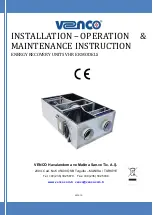
Before a emp ng to weld on a finished piece of work, it is recommended that prac ce welds be made on
a sample metal of the same material as that of the finished piece. The easiest welding procedure for the
beginner to experiment with MIG welding is the flat posi on. The equipment is capable of flat, ver cal and
overhead posi ons. For prac cing MIG welding, secure some pieces of 1.6mm or 2.0mm mild steel plate
(150 x 150mm). Use 0.9mm flux cored gasless wire or a solid wire with shielding gas.
Manual MIG welding setting requires some prac ce by the operator, as the machine has two control
settings that have to balance. These are the Wire Speed control and the Welding Voltage control.
Voltage is essen ally the power in the welding arc that sets the heat. The wire speed feed simply controls
the rate at which the welding wire is fed into the weld pool. For any voltage posi on setting, there will be
a specific corresponding ‘sweet spot’ in the wire feeding speed that will give the smoothest and most stable
welding arc. The correct wire feeding speed for a given voltage setting is affected by welding wire type and
size, shielding gas, welding material and joint type.
The recommended process for setting a MIG (in Manual mode) is:
1. Set the welding voltage as desired
2. Slowly adjust the wire speed un l the arc is smooth and stable.
3. When reaching this point, if the penetra on/ heat input is too much/ not enough, adjust the
voltage se ng and repeat the process.
4. If not able to achieve a smooth and stable arc with the desired heat input for the weld, it is likely
that a change in wire size and/or shielding gas type is required (assuming all other factors are
correct).
Synergic func on makes the setup of MIG welding much simpler as follows:
1. Choose Synergic program to suit wire type and size and shielding gas
2. Select amperage output or material thickness
3. The machine calculates the op mal voltage and wire speed for the applica on
4. Obviously other variables such as welding joint type, posi on and thickness, air temperature can
affect the op mal voltage and wire feed setting, so voltage can be adjusted to fine-tune for
op mal performance.
The welding current (amperage) is determined by the Wire Speed control.
Increased Wire Speed will increase the current and result in a shorter arc.
Less Wire Speed will reduce the current and lengthen the arc.
Increasing the welding voltage hardly alters the current level, but lengthens the arc. By decreasing the
voltage, a shorter arc is obtained with a li le change in current level.
When changing to a different welding wire diameter, different control se ngs are required. A thinner
welding wire needs more Current (Wire Speed) to achieve the same current level. A sa sfactory weld
cannot be obtained if the Current (Wire Speed) and Voltage se ngs are not adjusted to suit the welding
wire diameter and the dimensions of the work piece.
5.8 Establishing the Arc and Making Weld Beads
5.9 MIG Voltage & Wire Speed Settings
5.9.1 Setting Wire Speed/Amperage
5.9.2 Setting Voltage
5.9.3 Changing to a different welding wire
16
www.strata.co.nz
EZIMIG185C
Содержание EZIMIG185C
Страница 12: ...Figure 33 Figure 34 Figure 35 Figure 36 11 www strata co nz EZIMIG185C ...
Страница 43: ...9 3 Electrical schematic drawing 42 www strata co nz EZIMIG185C ...
Страница 45: ...44 www strata co nz EZIMIG185C ...
Страница 46: ...45 www strata co nz EZIMIG185C ...
Страница 47: ...46 www strata co nz EZIMIG185C ...
















































